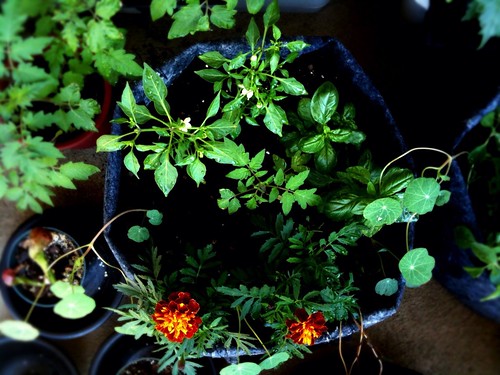I first learned about grow bags while surfing one of the online gardening websites. They were selling grow bags for growing specific produce. These grow bags came in different colors. They looked like an interesting way to garden fresh produce like carrots and tomatoes. While surfing on another gardening website, I came upon Root Pouch, pots made with felt and have handles. They looked like really nice designer bags instead of bags you'd grow things in.
To quell my curiosity, I went to the Root Pouch website and discovered they are an American company based in Oregon. The root pouch are biodegradable and are available in various sizes and years it will take to break down. The product line also include vertical hanging gardens and another product called saddle pouch, which I just adore.
One of the interesting features I read about using root pouch vs. other types of planting containers is the air circulation, which benefits the plants and improved health and growth of the root ball. It never occurred to me that the roots needed air circulation when growing in containers. Their point proper air circulation through the the roots made sense.
I acquired a 10 pack of 7 gallon root pouch pots with handles and used them when re-potting two of the Japanese maple trees into plastic containers that were too large. With the remaining space, I planted perennial ground cover like oxalis and succulents. You will notice a divider between the oxalis with the tree trunk. As the ground cover settle and grow, they will hide the rest of the Root Pouch.
I've also used the 7 gallon root pouch for growing herbs with tomato plants. The size of the 7 gallon is perfect for companion growing like tomatoes with basil, chives, cilantro hot peppers, oregano, parsley, marigolds, and nasturtiums. Since the tomato plants tend grow very tall, they were planted in the center while the herbs went around.

And I recently got some 5 gallon and 3 gallon Root Pouches for uses with tomato plants and mini roses. I wish the 3 gallon were available with handles - that way I can handle the mini roses with pricking myself accidentally.
The only issue I have with the root pouch is that they are available in sizes that are taller than they are wide. While there are uses for this format, it becomes useless and wasteful for those who would like to grow plants that do not require such depths. Though this issue is easily solved by folding down to the desired height, I think it would be best if lower sizes would be considered for future product developments.
I can't say that I've noticed a considerable benefit to the plants' growth and development since using the Root Pouch especially when it's my first time gardening at this capacity but I do like their pots as an alternative to plastic planters and impact it has on the environment. The pots are made of recycled material and it breaks down over time as opposed to creating more waste.
One of the reasons why I started to garden was because I wanted be a bit more sustainable in consumption and waste. With this is in mind, it just made sense for me to use Root Pouch. It's made with recycled materials, it breaks down over time especially when used with plants placed into the ground, and I can store and reuse these pots easily without taking up too much space. For more information about Root Pouch, I highly recommend that you visit their
website.
